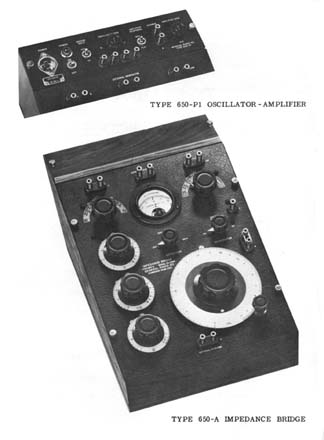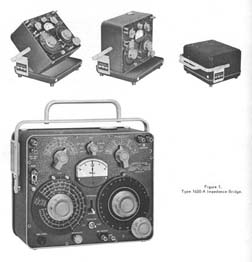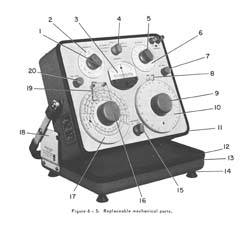General Radio Impedance Bridge Page
| Download 113MB | (Watch this spot!) |
General Radio 650-A Instruction Manual This manual describes the theory and operation of the impedance bridge. It has a full set of schematics of the bridge and its companion (vacuum-tube) oscillator. |
| Download 138MB | (Watch this spot!) |
General Radio 1650-A Instruction Manual This manual describes the theory and operation of the impedance bridge. It has a full set of schematics of the bridge and oscillator. |
| Download 138MB | (Watch this spot!) |
General Radio 1650-B Instruction Manual This manual describes the theory and operation of the impedance bridge. It has a full set of schematics of the bridge and oscillator. This is the most complete manual of the three. It has a number of half-tone images of the interior of the unit and the construction. There are quite a few pages of instructions as to how to use bridges in their various modes of operation. |
Various Scanned General Radio Manuals
Here are a number of other General Radio equipment manuals. I haven't had time to write up anything cool about the equipment, but if you need the documents, here they are. As I scan them, I'll just stack them up here.
| Download 16MB |
General Radio 1862-A Instruction Manual Vacuum-tube megohmmeter. |
| Download 24MB |
General Radio 1862-B Instruction Manual Vacuum-tube megohmmeter. |
| Download 54MB |
General Radio 1862-C Instruction Manual Vacuum-tube megohmmeter. |
| Download 13MB |
General Radio 1110-A Instruction Manual Interpolating Frequency Standard. |
| Download 13MB |
General Radio 1218-B Instruction Manual Unit Oscillator 900-2000 MHz. Tuned Klystron oscillator. |
| Download 12MB |
General Radio 1360-A Instruction Manual Microwave Oscillator. |
| Download 16MB |
General Radio 1362 Instruction Manual UHF Oscillator 220-920 MHz. |
| Download 38MB |
General Radio 1391-B Instruction Manual Pulse, Sweep and Time Delay Generator. |
| Download 21MB |
General Radio 1398-A Instruction Manual Pulse Generator. |
| Download 49MB |
General Radio 1606-A Instruction Manual RF Bridge. |
| Download 29MB |
General Radio 1608-A Instruction Manual Impedance Bridge. This was the most accurate of the passive bridges. It was not portable. It was a shop-desk unit. |
| Download 5MB |
General Radio Ganged Variacs Instruction Manual Catalog. Has lots of technical information. |
| Download 5MB |
General Radio V5 Variac Instruction Manual Manual on the V5 (5-amp) variac. Has pinouts. |
| Download 5MB |
General Radio V20 Variac Instruction Manual Manual on the V20 (20-amp) variac. Has pinouts. |
| Download 10MB |
General Radio Variac Catalog 1961 Instruction Manual Catalog. Has lots of technical information. |


